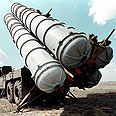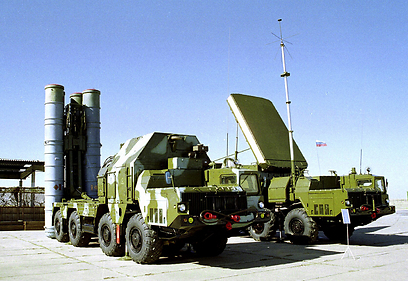
Solution to S-300 missiles needed, before it's too late
Past experiences taught Israeli military establishment valuable lessons regarding Russian missiles: Every system has technological, operational response. Nonetheless, no need to jump to conclusions regarding immediate danger posed by S-300
As a result of the arms shipment, the Israeli military and civilian home front may absorb hundreds of heavy rockets and missiles. These systems may also jeopardize vital civilian activities, such as take-offs and landings at Ben Gurion Airport, as well as offshore gas drilling.
Past experience has shown that for every military technological system there is a technological or operational answer that can neutralize it. It is safe to assume that Israel's army, Air Force and military industries can find solutions – within a relatively short period of time – to the problems posed by the S-300 missiles, on the condition that the IDF speeds up its work on this solution.
And yet, when considering the missile threat, we must recall a number of past incidents and facts from which we can draw the necessary lessons: The sinking of the INS Eilat in 1967 by the Egyptians with Russian sea-to-sea missiles; the decades that passed before the security establishment woke up and began developing a Katyusha-intercepting system; and, most importantly, we mustn't forget the price the Air Force paid in the Yom Kippur War only because the State of Israel failed to respond when the Egyptians advanced USSR-made anti-aircraft missile batteries to the Suez Canal.

Suez Canal. War of Attrition (Photo: Moshe Milner, GPO)
That move was a blatant violation of the ceasefire agreement which ended the War of Attrition 43 years ago, but at the time, Israel succumbed to American pressure and did not authorize the Air Force to destroy those missile batteries, even after the Egyptian army used them to ambush an Air Force cargo plane: The slow Stratocruiser plane, which was flying fairly deep over what was then Israeli-controlled Sinai, was downed. But Israel continued to accept the existence of a Russian-Egyptian intercepting-umbrella over the canal and over the areas in which the IDF was preparing for the Egyptian army's crossing of the canal from the west.
The result is known: During the war the Air Force lost dozens of planes and pilots as it tried to attack the bridges the Egyptians used in order to cross the canal and butcher IDF soldiers.
Despite the fact that at the time, the current IAF commander, Maj-Gen Amir Eshel, was only a schoolboy, the trauma of the aforementioned events still lives one, and its troubling implications are a matter of concern not just for the IAF's boys in blue but also for the entire defense establishment, including both the defense minister and the prime minister himself. What happened in 1973 with the SA-2, SA-3, SA-4, SA-6 missiles could repeat itself in a number of months with the modern SA-17, S-300 and Yakhont missiles.
Hence the Kremlin should understand the words of Defense Minister Moshe Ya'alon and National Security Adviser Yaakov Amidror regarding the S-300, in their most practical sense. "Israel will know what to do," Ya'alon declared throughout the media, and Amidror clarified the defense minister's statement before a group of European diplomats saying that "Israel will not allow these systems to become fully operational." Those who know what's what will say Amidror's statement hints at the Israeli line of action all the while offering the Russians a way of backing out of the corner into which they have backed themselves, at least if they so desire.
Unanswered questions
So, how dangerous are the Russian missiles? In this regard it is worth pointing out the components that designate how dangerous a weapon system is:
1. The make and model of the radar and missiles which arrived in Syria. The S-300 has a number of different models of radar and missiles, some of which are more advanced (and hence more dangerous) and some less so. Whatever the Russians did send Assad needs to be thoroughly examined.

Operational or not? (Photo: AP)
2. Will these systems be passed on to Hezbollah? Responsible and senior sources seriously doubt that Hezbollah will be given a system as advanced as the S-300. They are too complex and too big, and politically the Russians will not allow the Syrian regime to pass the systems onto a non-state agent to which the UN forbids weapon transfers.
Nonetheless, it is possible that Assad will place the systems in the southernmost tip of the Alawite's Syrian enclave, where they will pose a definite threat to our planes and activities in Lebanon.
3. The fact that Syrian soldiers received training in operating the system in Russia, and that certain components of the anti-aircraft system have already arrived in Syria still do not prove that the system is operational and dangerous to Israeli planes. For that to happen the delivery of all the system's parts must be completed and the parts need to make it to their destination safe and sound; those operating them must be adept in putting the system together and into action; the system itself needs to be posted in sites from which it could be operationally active and where interference or any other malfunction regarding its operationality could be examined. In other words, everything needed for it to become operational needs to happen and that could take up to anywhere from a couple of months to a few years. Until then, these systems serve more as an opportunity for us than a threat.
4. The number of interception missiles is also crucial for assessing the magnitude of the threat the system poses.
5. The Russians are well known for invoking their creativity in regards to closing arms deals; in other words: Things happen, the media repots, but in reality something slightly (or completely) different takes place. The Russians have a clear interest not to anger the West beyond a certain point, thus pushing it to arm the rebels. They want a peace conference, but on their terms.
The conclusion is that we should wait and seriously scrutinize what really went where and to whom before we jump to the conclusion that these systems have already become an unbearable threat to Israel. This goes for the S-300 as well as the other systems which the Russians plan to transfer to Syria.
None of this changes the need to formulate – as soon as possible – "soft" as well as "hard" responses to the problem of scale tipping arms systems which are probably currently en route to Syria.
- Receive Ynetnews updates directly to your desktop










